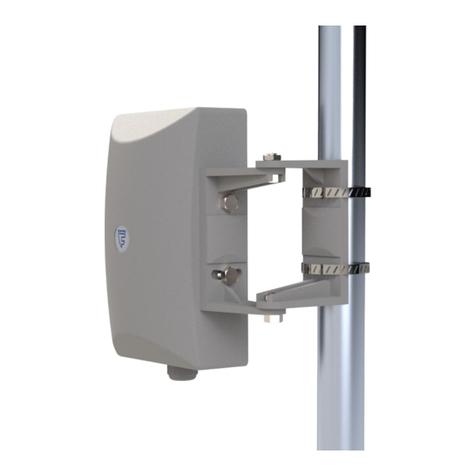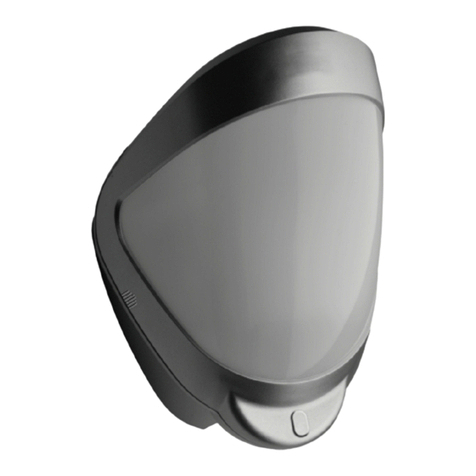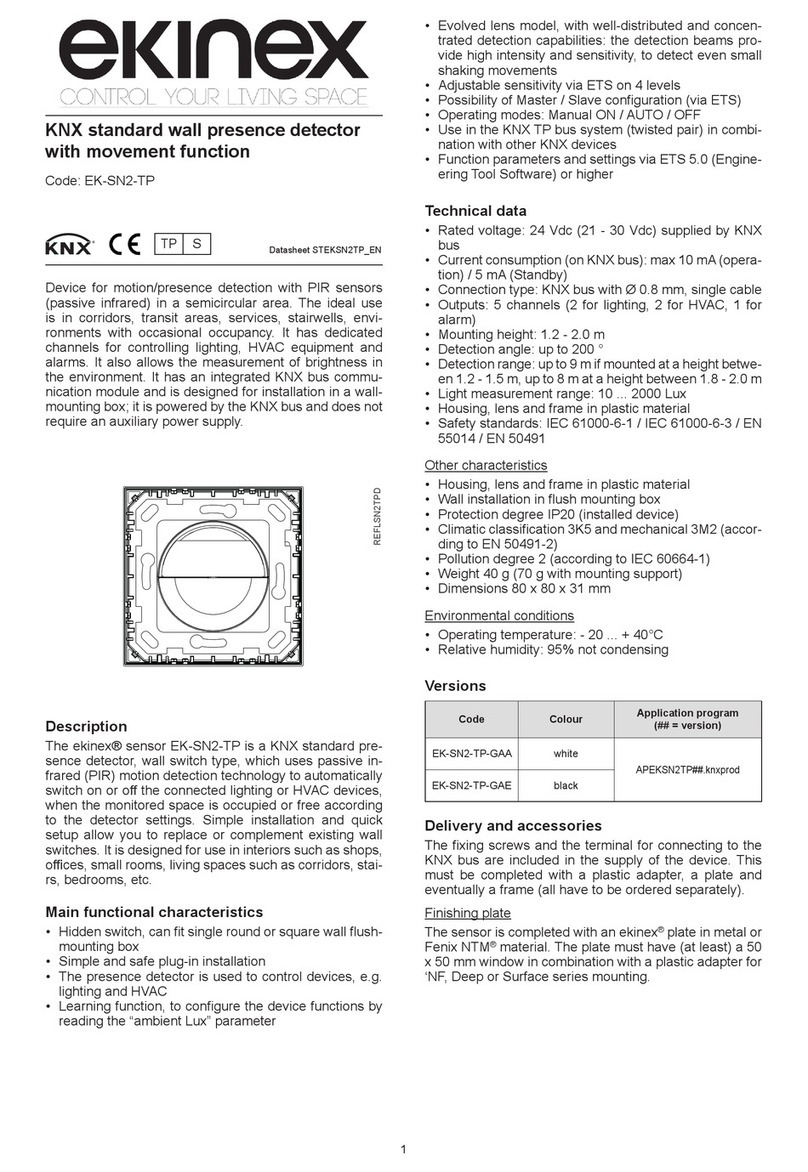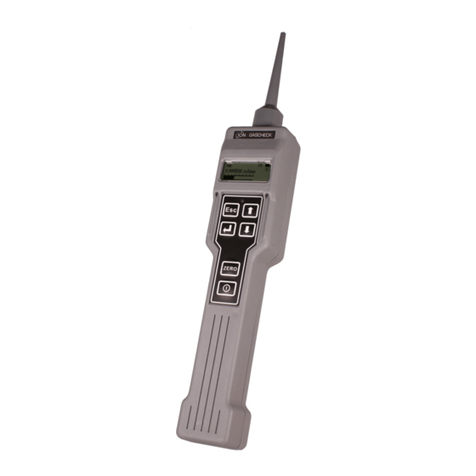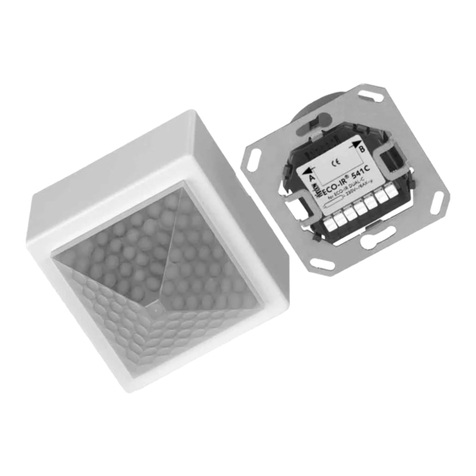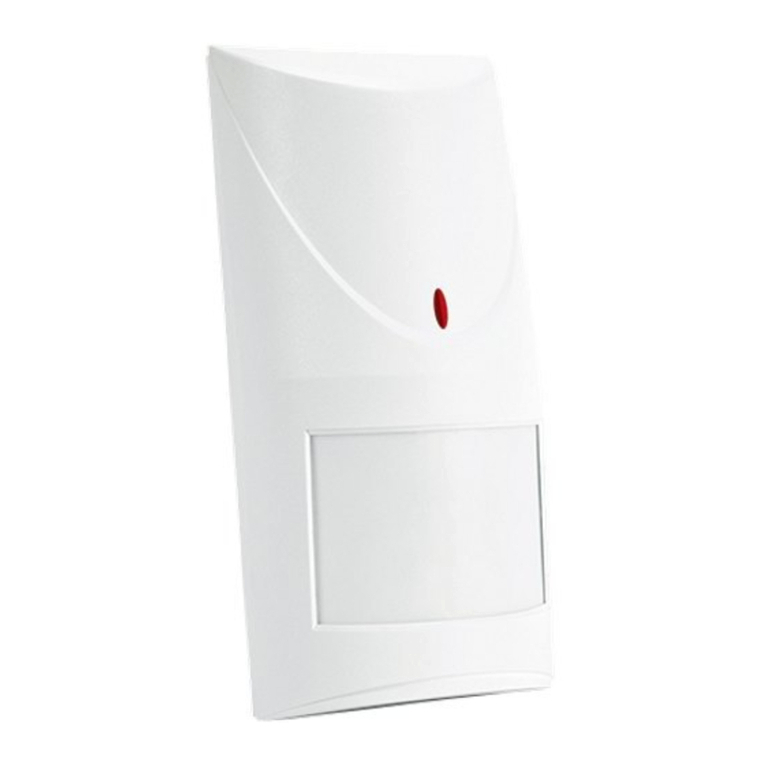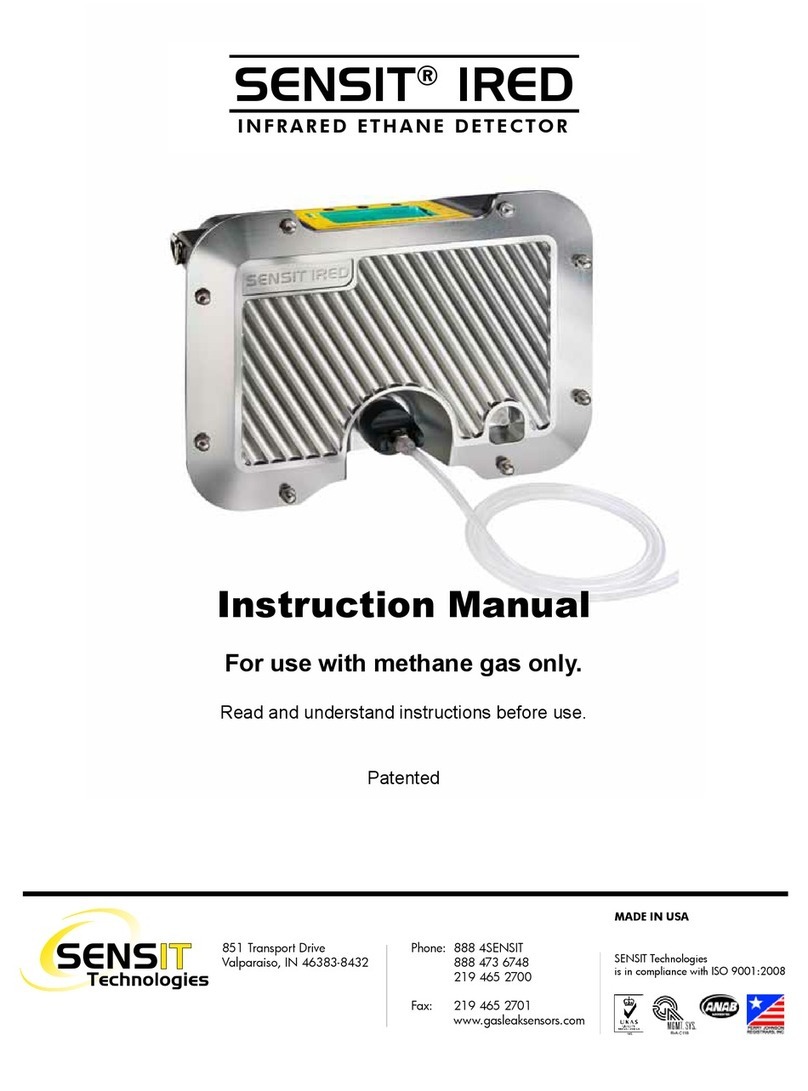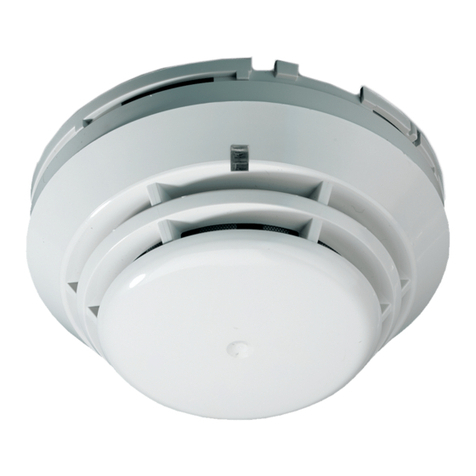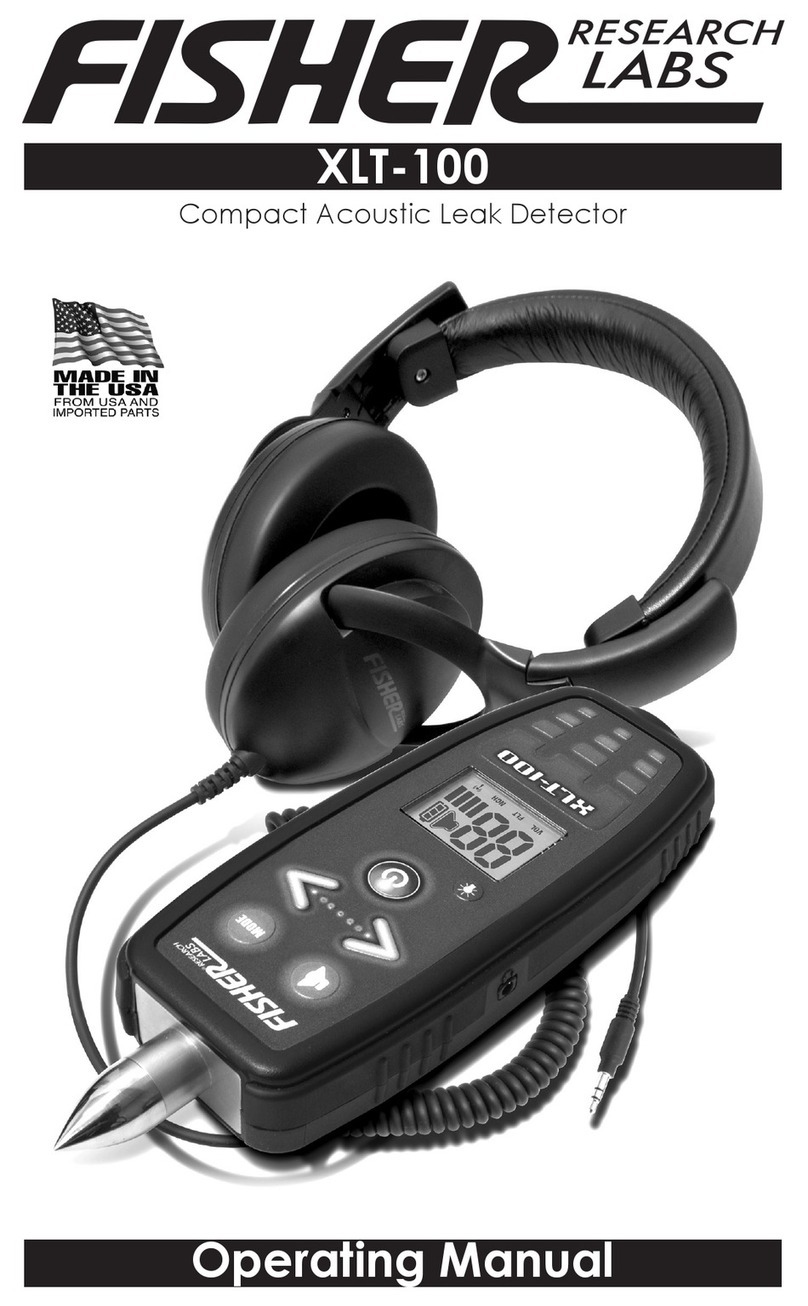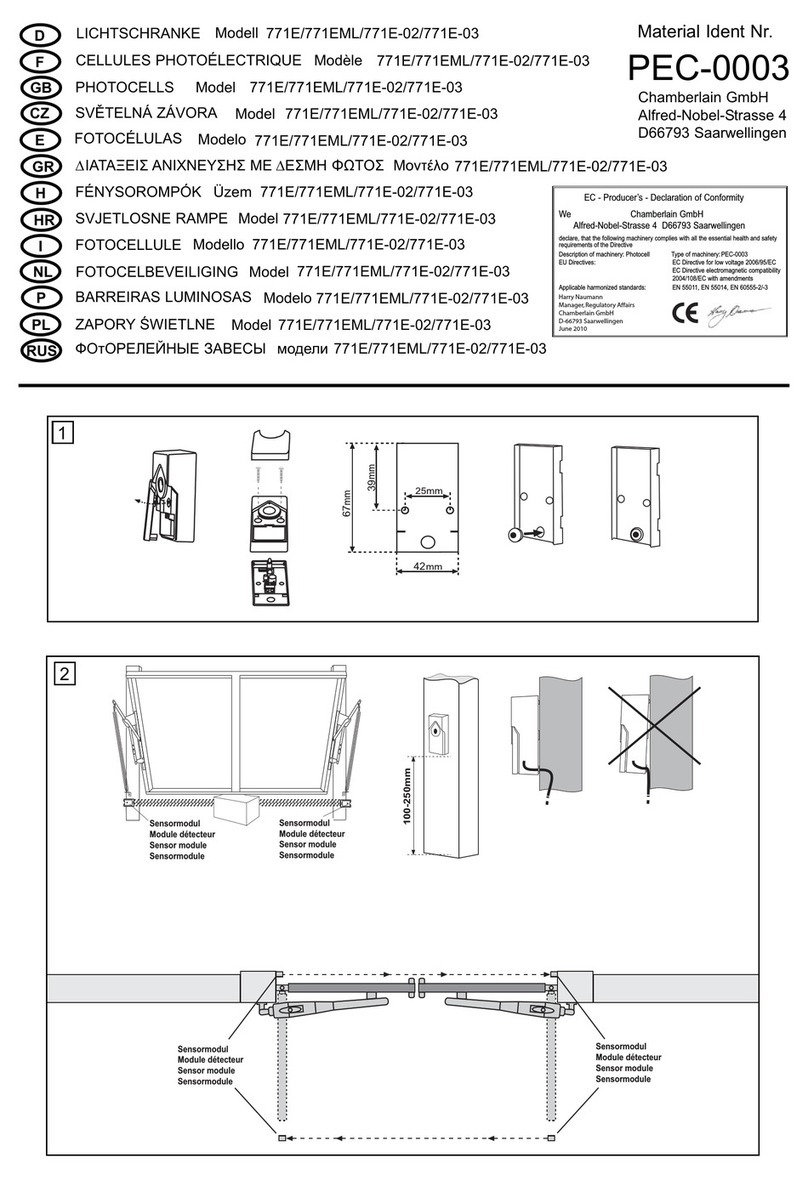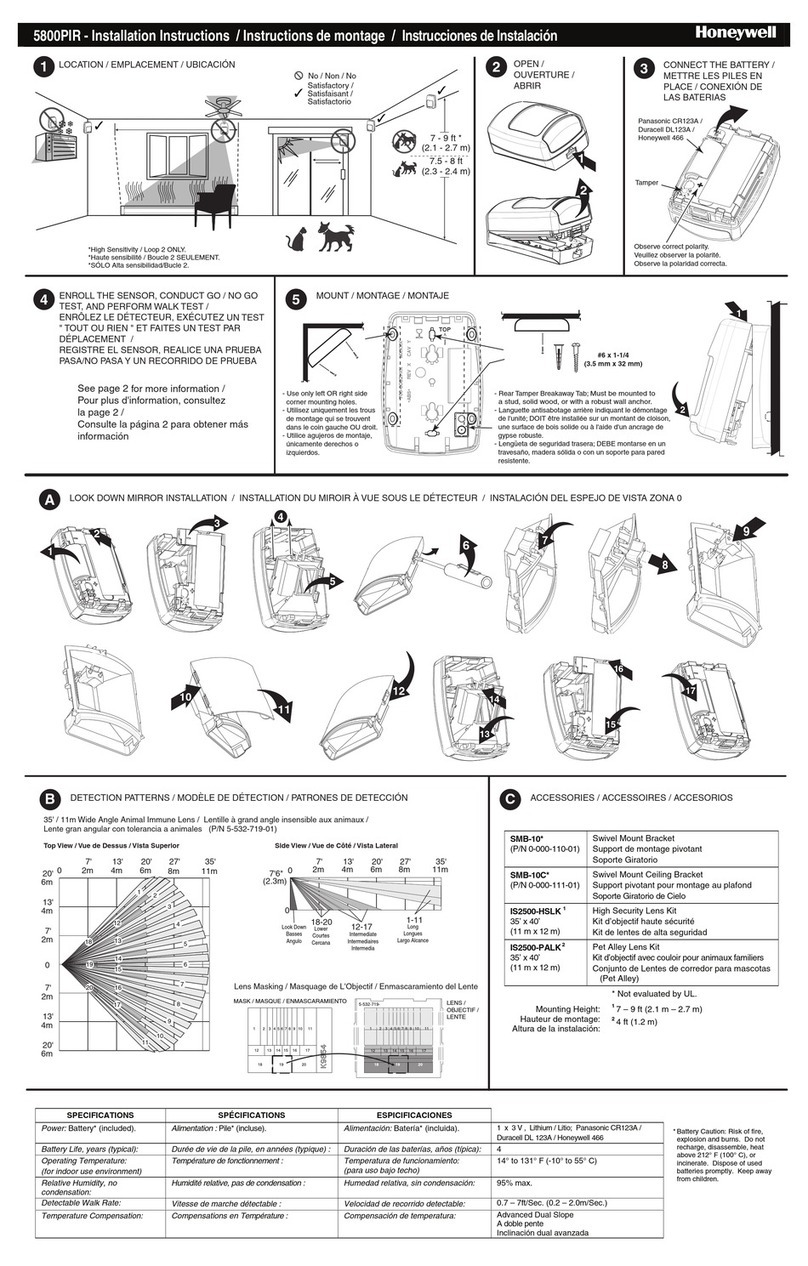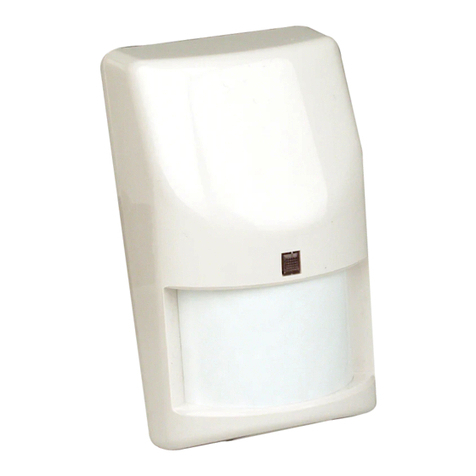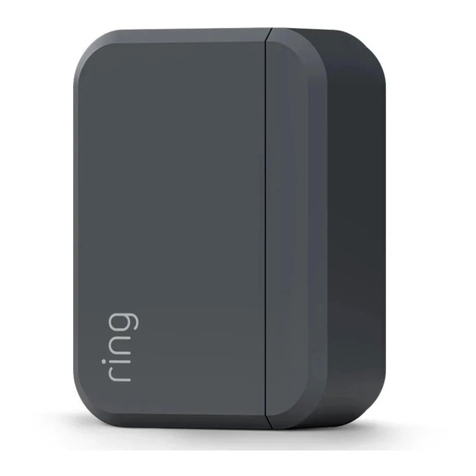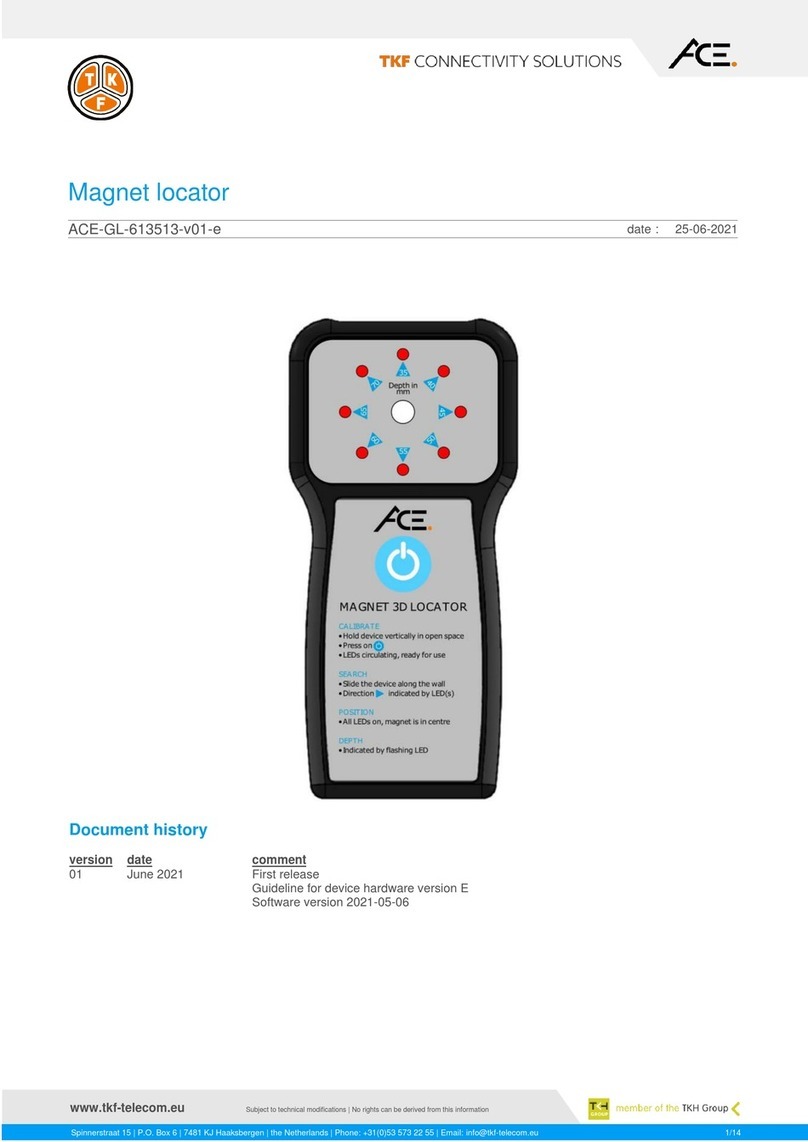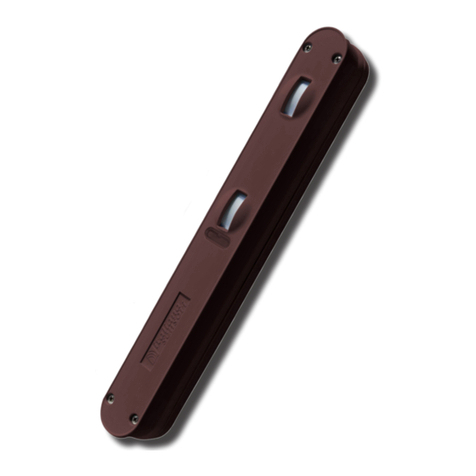FORTEZA Forteza-50 Operating instructions

JSC FORTEZA FORTEZA-50, 100, 200
Please visit our internet sites: www.forteza.com www.forteza.eu Page 2
CONTENTS
1. Introduction.....................................................................................................................3
2. Purpose............................................................................................................................3
3. Specifications..................................................................................................................3
4. Detector Components......................................................................................................5
5. Detector Structure & Operation ......................................................................................5
5.1. Detector Principle of Operation ...................................................................................5
5.2. Adjustment, Control and Indication Parts....................................................................5
5.3. Detector Operation.......................................................................................................6
6. Detector Construction .....................................................................................................6
6.1. Rx Construction............................................................................................................6
6.2. Tx Construction............................................................................................................7
6.3. MK (mounting kit).......................................................................................................7
7. Safety Measures……………………………………………………………….………. 12
8. Mounting Procedure…………………………………………………………………… 12
8.1. Requirements for the preparation of the sector and the
arrangement of Rx and Tx ……………………………………………………………….. 12
8.2. Sensor Mounting………………………………………………….………………….. 12
8.3. Sensor Connection…………………………………………………………………… 15
9. Preparation of the Detector for the Operation & Adjustment……………………….... ..20
9.1. Detector Preparation for its Operation…………………………………………..…… 20
9.2. Adjustment of Tx and Rx..............................................................................................20
9.3. Rx threshold …… ........................................................................................................ 20
10. Check of Technical State............................................................................................... 21
11. Troubleshooting Guide.................................................................................................. 22
12. Storage ......................................................................................................................... 23
13. Transportation ............................................................................................................... 23
Certificate............................................................................................................................ 24

JSC FORTEZA FORTEZA-50, 100, 200
Please visit our internet sites: www.forteza.com www.forteza.eu Page 3
1. INTRODUCTION
The present description manual and service instruction contains information about the operation of the local
microwave protective detectors “Forteza-200”, “Forteza-100”, “Forteza-50” (below the detector). In this document there is
information required for the correct operation (use, transportation, storage and maintenance) of the detector.
The following abbreviations are used in the present document:
Tx - transmitter
Rx - receiver.
2. PURPOSE
2.1. The purpose of the detector is to protect the perimeter sectors and to detect an intruder
crossing at his full height or bent (crawling) through this sector.
2.2. The detector is intended for continuous round-the-clock outdoor operation at an ambient temperature -
40ºC…+65Сand relative humidity up to 98% at the temperature +35С.
3. SPECIFICATIONS
3.1. The recommended length of a sector for modifications:
“Forteza-200” – 10…200 m
“Forteza-100” – 10…100 m
“Forteza-50” –5…50 m
3.2. The configuration and the dimensions of the detection zone are given in fig.3.1. and table
3.1. The detection zone is a volumetric part of a sector that being the very specialty in the kind of
detection, and any movement within this sector will generate an alarm.
Fig.3.1.
L- Length of a sector
h- Height of detection zone
b- Width of detection zone
In fig.3.1 and table 3.1 the height (h) and the width (b) of the detection zone are given for the
middle of the sector. Moving towards the receiver or transmitter these dimensions decrease evenly,
given the geometry of positioning the receiver and transmitter.
Table 3.1.
h
L
b
3
-
5
m
0,85 m
Axis of the
Detection zone
Rx
Tx

JSC FORTEZA FORTEZA-50, 100, 200
Please visit our internet sites: www.forteza.com www.forteza.eu Page 4
Dimensions,
maximum,
m
Length of a sector L, m
10
25
50
100
200
h
1,4
1,6
1,8
b
0,5
0,7
1,0
1, 5
2, 1
3.3. The distance recommended from the axis of the detection zone up to guarding, building
walls and other nonmoving objects should be as follows:
80…200m - 1, 1 m minimum
25…80m - 0, 8 m minimum
10…25m - 0, 4 m minimum
3.4. The detector generates an alarm when:
- An intruder crosses a detection zone (perpendicularly to the axis) at a speed of 0, 3…10
m/sec at his full height or bent (crawling through) with the minimum detection probability of 98 %;
- RC signal is given on Tx;
- Electromagnetic field influences on Rx for its masking. An alarm can be absent but in this
case the detector saves its availability.
An alarm is generated by breaking the contacts of an individual point opt electronic relay for
the time 3 sec minimum. This signal is sent from Rx by yellow and pink colored wires marked “NC”
(normally closed); “NC” (normally closed).
Note. At the distance of 3-5 m from the supports on which Tx and Rx are installed, the
probability of the intruder’s detection who is bent (crawls through) is 98 % because a person can
move bent and pass below the detection zone.
3.5. The detector generates a fault signal in the case:
- The absence of the signal from Tx
- In the absence of power supply or when the voltage drops below 9 V.
- Failure of Rx or Tx.
A fault signal is generated constantly (latching) till the same is rectified and indicated by
break in the contacts of an individual point optoelectronic relay indicated by yellow and pink colored
wires marked “NC”; “NC”.
3.6. The dimensions of an individual point optoelectronic relay are: the maximum switching
current is 0,1A; the maximum voltage is 50 V; the maximum resistance is 100 Ohm in the closed
status (with the elements of storm protection).
3.7. Removal/ opening of the back inspection cover of the Rx unit generate a tamper alarm. The
contacts of the tamper circuit are broken and this is reflected at the Rx unit through the green and grey
colored wires marked “TAMPER”, “TAMPER”. Contacts rating of this tamper circuit are: current up
to 0,2A at voltage up to 80 VDC.
3.8. The detector power supply is: 9…30 VDC with a maximum pulsation of 0,02 V
maximum. The maximum current consumption is 35 ma at 24 VDC.
3.9. The detector operation can be tested by applying 5…30 VDC signal at the RC on the Tx
unit. The RC is marked as “RC” (remote control) input of the transmitter. The duration of this test
signal is 1…3 sec.
3.10. The detector doesn’t generate an alarm when:
-precipitations such as rain, snow, thick fog
-solar radiation
-the influence of wind at a speed of 30 m/sec. maximum
-moving of the objects in the DZ (detection zone) of 5 m from Rx or Tx of the objects
with the linear dimensions of 0,2 m maximum (birds or small animals)
-irregularities on the sector up to ± 0, 3m
-snow without additional adjustment up to 0, 5 m
-grass up to 0, 3 m

JSC FORTEZA FORTEZA-50, 100, 200
Please visit our internet sites: www.forteza.com www.forteza.eu Page 5
-influence of the radiated emission of ultra short waves of the range 150-175 MHz up
to 40 Vat on the distance 6 m maximum.
3.11. The detector is immune to EMI: voltage impulses in supply circuits, breaks of main
supply, electrostatic discharges, and electromagnetic fields.
3.12. Input circuits of Tx and Rx are protected from electric pickup (electric storm too).
3.13. The detector mean lifetime is 8 years.
3.14. Maximum dimensions of the units without a mounting kit, mm:
Tx - 211*130*105
Rx - 211*130*105
3.15. Maximum weight of the units with a mounting kit, kg:
Tx - 1,2
Rx - 1,2.
4. DETECTOR COMPONENTS
The detector delivery kit is:
1. Receiver –1 item
2. Transmitter - 1 item
3. Mounting kit including:
-Bracket –2 items
-Buckle –4 items.
4. Kit of tools and accessories including:
-Alarm cable
-Key S8*10.
5. Description Manual & Service Instruction
6. Package. 5. DETECTOR STRUCTURE & OPERATION
5.1. Detector Principle of Operation
5.1.1. The detector is a bistatic microwave detector.
The principle of the detector operation is to generate an electromagnetic field in the space between a
transmitter and a receiver. This field provides a volumetric detection zone in the form of a long
ellipsoid of rotation (see fig.3.1.). An intruder crossing a detection zone causes changes of the field.
All changes of this field are recorded. There is the detection zone configuration in fig.3.1, there are
given in table 3.1 its crosscuts dimensions for three performances of the detector dependency on the
length of a sector with the height 0, 85 m of Rx & Tx mounting.
5.1.2. An intruder crossing a detection zone causes the change of the signal magnitude on Rx
input. The signal passes through the amplifier and is compared with the value thresholds according to
the algorithm. If the signal’s change on Rx input is provoked by a person passage, Rx generates an
alarm breaking output contact of the relay.
5.1.3. The signal on Rx input can be changed under the influence of other factors: rain, grass,
small animals, electromagnetic interference, swinging of branches, gates entering the detection zone
commensurable with an intruder movement. Other reasons, e.g. location of extensive constructions,
objects in the detection zone or near from it like as fences, walls, irregularities, snow, grass can
influence on the level of Rx input signal. In theses cases because of big reflections and interference the
detection zone configuration jumps. Multi thresholds algorithm of the detector operation permits to
decrease the number of alarms provoked by interference. That’s why it is necessary to observe the
recommendations in the subsection 8.1!
5.2. Adjustment, Control and Indication Parts
5.2.1. An alarm generates the values of the Rx thresholds. An explorer establishes them during
the operation with the controller of the thresholds “MIN-MAX”. The thresholding is realized by the
main rotation of resistor axis with screwdriver. In this case the thresholds will change from minimum
(MIN) to maximum (MAX) value.

JSC FORTEZA FORTEZA-50, 100, 200
Please visit our internet sites: www.forteza.com www.forteza.eu Page 6
5.2.2. The input signal is controlled with the tester on the socket that is marked "TEST" (test
jack).The more TEST the more Rx input signal and vise versa. The detector keeps its operation with
the range of the voltage values too: TEST 0,1-4,8 V.
5.2.3. The light indicator “PROTECTION” provides the indication of the mode operation of the
detector:
-Continuous luminescence means the standby state of the detector;
- The indicator’s switching off for 3 sec means the alarm generation.
5.2.4. During Rx and Tx adjustment on the maximums of the antennas directional diagrams, the
amplifier is transferring from the mode of the adjustment with a big time constant to the mode with a
small time constant by pressing the button “AGC” (automatic gain control) on Rx. In this case an
express setup of the amplifier takes place on the standby state.
5.2.5. A “normally closed” tamper loop is provided to prevent unauthorized opening of the
back panel of the Rx unit. In the operating condition the tamper circuit’s contacts are closed, during
the back panel opening they are broken. The circuits of alarm cables marked “TAMPER”; “TAMPER”
(green and grey wires) are broken too.
5.3. Detector Operation
5.3.1. The detector operation provides the following suite:
-Preparation of the sector
-Signal cables and power supply laying
-Tx and Rx installation
-Detector’s connection (connection of power supply and loops of intruder alarms)
-Alignment of Tx and Rx antennas
-Setup of Rx thresholds.
The principles and the methods of the operations’ performance are given in items 8-10.
5.3.2. The detector has the following operating regimes:
-Standby state (contact breaking)
-Alarm signal (open condition)
-Tamper state of Rx (the contacts of the tamper circuit are opened).
5.3.3. The receiver control device realizes the receipt and the indication of alarms. The detector
operates with the receiver control devices providing the check of the relay contacts.
5.3.4. During the operation the remote control checks the detector efficiency.
The constant voltage 5…30 V for 1…3 sec is realized on the Tx green wire marked “RC”. The
beaming of Tx is interrupted for the time of the signal “RC” operation. Then Rx generates an alarm. In
such a way the signal generation after the signal “RC” confirms the detector’s operation and the
running order of the loop.
The user determines the control periodicity.
5.3.5. Besides there it is necessary to check periodically the technical state of the detector and
its servicing. Periodicity of the checks is given in item 11.
6. DETECTOR CONSTRUCTION
6.1. Rx Construction
6.1.1. The detector consists of separate units (Rx, Tx) placed in dust-, splash-proof enclosures.
6.1.2. Rx Construction and its fastening elements to the support are given in fig. 6.1. The
carrier of the unit is base 4. Radio transparent enclosure 5 is glued to the base with sealing material. In
the heel of the enclosure there are two holes preventing condensed fluid accumulation within the unit.
The access to the controls, adjustment, indication elements and clamps for the connection of the
terminal element is open when the cover 6 is removed. Rx is connected to the receiver control device
with six wires cable 8. Rx is mounted on the support 1 using the bracket 2 and two bucles13. Mounting
provides the rotation of the unit horizontally at angle +65minimum; vertically: upward - at angle 30
minimum, downward –at angle 45minimum (if the bolt 12 is eased). Location and marking of the
clamps, controls, and adjustment and indication elements located under the cover 6 are shown in fig.
6.2.

JSC FORTEZA FORTEZA-50, 100, 200
Please visit our internet sites: www.forteza.com www.forteza.eu Page 7
6.2.Tx Construction
6.2.1. Tx construction and its bracket are the same as the Rx construction (see fig.6.1). The
difference is in internal elements: cover 6, clamps, controls, adjustment and indication elements are
absent; three wire cables are used instead of cable 8.
6.3. MK (mounting kit)
6.3.1. Mounting kit includes two brackets and four buckles for the mounting on the support of
Rx and Tx.
1-support - 1 item 8-cable - 1 item
2- bracket - 1 item 9-ring - 1 item
3- figured washer - 2 items 10-nut M6 - 1 item
4-base -1 item 11-washer 6 -2 items
5-enclosure - 1 item 12-bolt M6*16 - 1item
6-cover -1 item
7- corrugated tube - 1 item 13-buckle- 2items
Fig.6.1

JSC FORTEZA FORTEZA-50, 100, 200
Please visit our internet sites: www.forteza.com www.forteza.eu Page 8
Fig.6.2.
Note. Dear user! The manufacturer of the detector constantly upgrades their quality and reliability.
That’s why in some lots of detectors one can find design modifications unspecified in the documents
delivered with the detectors. Nevertheless, the main specifications are valid.
1 - indicator "PROTECTION"
2 –threes holding “MIN-MAX”
3 - socket "TEST"
4 –“AGC” button
5 - tamper circuit
6 - marking of cable cords

JSC FORTEZA FORTEZA-50, 100, 200
Please visit our internet sites: www.forteza.com www.forteza.eu Page 9
Fig.6.3
Table 6.1.
Sensor
Max detection
zone length (L),
m
Max detection
zone width (B),
m
Max detection
zone height (H),
m
Notes
FORTEZA-200
100
1,5
1,5
FORTEZA-100
100
1,5
1,5
FORTEZA-50
40
1,0
1,0
Notes.
1. If the upper part of the fence is protected with physical protection devices, it is necessary to
use the bracket of 500 mm. If the upper part of the fence is not protected with barbed wire,
it is recommended to use the bracket of 350 mm.
2. The height of Rx and Tx units for the protection of the fence upper part is equal to the
fence height ±100mm.
3. The dimensions and materials of the fence are not specified. It is necessary to provide the
fence rigidity.
4. The detection zone dimensions B and H are given for the correct alignment of the sensor
according to the item 9.
5. The bracket of 120 mm is used if the beaming direction of the unit is perpendicular to the
support plane or if the beaming direction is within the angle range 90± 40.

JSC FORTEZA FORTEZA-50, 100, 200
Please visit our internet sites: www.forteza.com www.forteza.eu Page 11
Fig. 6.5
1- fence –1 item; 7- bolt М6х35 –1item;
2- bracket –1item; 8- ring –1item;
3- figured washer –2items; 9- nut М6 –
2items;
4- bracket fastener –1item; 10- washer 6 –4items;
5- Rx unit –1item; 11- bolt М6х14 –1item.
6- screw М6х50 –4items;
Note. Dear user! Manufacturer of the sensor constantly upgrades its quality and reliability.
That’s why in some lots of sensors there can be design modifications unspecified in the
documents delivered with the sensors. Nevertheless, the main specifications are valid.

JSC FORTEZA FORTEZA-50, 100, 200
Please visit our internet sites: www.forteza.com www.forteza.eu Page 12
7. SAFETY MEASURES
7.1. The current safety standards for the operation with electrical facilities with the voltage up
to1000 V should be observed during mounting, preventive maintenance and repair of the
sensor.
7.2. Cables should be laid, terminated and connected to the sockets only when the supply voltage
is OFF.
7.3. The maximal value of the mean microwave flux density at the distance of 1 m from the sensor
is up to 1 mW/cm2. It satisfies safety regulations for persons, not dealing professionally with
microwave frequency.
7.4. It is prohibited to mount and maintain the sensor at thunderstorms.
7.5. Installation and maintenance of the sensor must be performed only by people, who underwent
special safety trainings.
8. MOUNTING PROCEDURE
8.1. Requirements to the protected sector preparation and the arrangement of Rx and Tx.
8.1.1. The sector, where Tx and Rx are located, should meet the following requirements:
a) height of irregularities –up to +0,3m. If irregularities exceed +0,3m, the sensor
characteristics can become worse. Under these conditions the possibility of the sensor
usage is defined by the trial operation.
b) grass height - up to 0,3 m;
c) snow height - up to 0,5 m;
d) maximum sector inclination –200;
e) single motionless objects (e.g. posts, tree trunks without lower branches) can be situated
in the detection zone at the distance of 0,5 m minimum from the detection zone axis;
f) moving leaves, bushes, trees and etc. should not be situated in the detection zone and
at the distance of 1,2 m from the detection zone;
g) sector width of the should meet the requirements of the item 3.3;
The sensor can be mounted if the sector width is less. In this case if the «TEST» voltage (item
9.2.) is less than 1,2 V, it is necessary to change Rx and Tx position relative to the support. If
it is not effective and the «TEST» voltage is less than 1,2 V, it is necessary to conduct the
operation test and make a decision about the possibilities of the sensor operation in these
conditions according to its results.
8.2. Sensor Mounting
8.2.1. Mark the perimeter for the places where the supports will be mounted. To organize the
continuous protected boundary, it is necessary to provide the overlapping of the sectors
detection zones (see fig.8.1. and 8.2). The overlapping is necessary to exclude the possibility
of the sector overcoming under or above Tx (Rx) unit near the support.
8.2.2. Mount the supports. As supports it is recommended to use metal or asbestos-cement tubes of
70…90 mm diameter. The height of the support above the ground surface is shown in fig.6.1.
In the snowy regions the superstructure of the support should be 1500 mm minimum.

JSC FORTEZA FORTEZA-50, 100, 200
Please visit our internet sites: www.forteza.com www.forteza.eu Page 13
Fig.8.1
Fig.8.2
8.2.3. The supports can be mounted with concreting.
The other variants of the sensor mounting (for example on a fence, on a building wall) can be
chosen according to the results of the operation test. As a fence deforms the detection zone
configuration, the sensor operation depends on the exact place of its mounting.
The example of the supports mounting is given in fig. 8.3.
8.2.4. Lay the main cables according to the project of the security system.
Mount the Rx and Tx brackets on the supports (see item 6.1.2). The height of the brackets (if
there is no snow) is chosen according to fig.6.1. The brackets are mounted on the supports
with two buckles (see fig.6.1).
8.2.5. Install Tx and Rx on the brackets with bolts 12 (fig.6.1).
ATTENTION! The right orientation of Tx and Rx on the bracket: drain ports should be
downwards!

JSC FORTEZA FORTEZA-50, 100, 200
Please visit our internet sites: www.forteza.com www.forteza.eu Page 14
Stretch the cable 8 through the corrugated tube 7. The installation of the corrugated tube is
obligatory.
8.2.6. Install junction boxes and power supply units (if according to the project PSU are installed
within the perimeter).
If you use junction boxes «JB-30» and power supply units «PSU-U-24-0,7», install them on
the supports together with the sensor units inside the protected perimeter. To connect the
cable 8, protected with the corrugated pipe 7, with the JB (or PSU), one should remove one of
the threaded cable connections PG9 and place the bushing 14 with the corrugated pipe 7 into
the hole. It is recommended to use one «PSU-U-24-0,7» for power supply of two contiguous
sensors. It should be remembered that there are five free terminal blocks in «PSU-U-24-0,7»
(«1» - «5»). That is why, it is not necessary to install a junction box on the support with this
power supply unit. Mounting elements are supplied with the delivery set of «JB-30» and
«PSU-U-24-0,7».
ATTENTION! To reduce the level of electromagnetic interferences, it is recommended
to mount the power supply unit at a distance up to 300 m from the place where the
sensors are installed.

JSC FORTEZA FORTEZA-50, 100, 200
Please visit our internet sites: www.forteza.com www.forteza.eu Page 15
1 - support;
2 - plastic plug;
3 - hole for the cable input inside the
support;
4 - hole for the main cable and sensor
cable input;
5 - hole for the main cable input;
6 - concrete (gravel);
7 - dowels for prevention the
unauthorized dismounting of the
support;
8- ground.
Fig.8.3
Note.
1. For A size the ground should
be laid after installation works.
2. Dimensions are given in millimeters.
8.3. Sensor connection
8.3.1.Connect the necessary power, signal and remote control circuits. Rx and Tx units are
connected with its own cables. The colour or marking of the cable conductors indicate their
purpose. The information about cable conductors marking, colour and purpose is given in
Table 8.1.Table 8.1
ATTENTION! It is categorically forbidden to «earth» the sensor circuits directly. It is
necessary to use the lightning guard unit «LGU-4»

JSC FORTEZA FORTEZA-50, 100, 200
Please visit our internet sites: www.forteza.com www.forteza.eu Page 16
Table 8.1
Rx
Tx
Colour
Purpose
Colour
Purpose
white
«+»supply voltage
white
«+»supply
voltage
brown
«-»supply voltage
brown
«-»supply
voltage
yellow
actuating relay contacts
«NC»
green
remote control
«RC»+5…30 V
pink
green
blocking button contacts
«TAMPER»
grey
8.3.2. The type and rating of the terminator of the security system loop (resistor, condenser and
diode) are determined by the type of the receiving-control device, with which the sensor is
connected. Usually it is a resistor. The rated resistance of this resistor should take into account
the resistance of the actuating relay contacts (≈10 Ohm), the lightning guard circuit (this
resistor - 100 Ohm) and the resistance of the security system loop (depends on the chosen
cable type and its length).
8.3.3. The contacts of the Rx blocking button («TAMPER») can be connected to the receiving-
control device with a separate loop. In this case the separate signal indicates the opening of
the Rx cover. The second variant is to connect the blocking contacts in series with the
actuating relay contacts. In this case an alarm will be registered by one channel of the
receiving-control device at the relay actuation or at the opening of the Rx cover.
8.3.4. The scheme of the sensor connection using the junction box «JB-15» is shown in Figure 8.4.
The contacts of the blocking button are connected in series with the actuating relay contacts.
The sensor receives a signal from the remote control (RC) when an additional button is
installed at the post. It is possible to install one button for several sensors. In this case the
button pressing checks the operation of all sensors.
The scheme of the sensor connection using the lightning guard unit «LGU-4» is shown in
Figure 8.5.
The scheme of the sensor connection to the supply unit «PSU-24-0,7» is shown in Figure 8.6.
8.3.5. On the lengthy perimeters it is recommended to use junction boxes «JB-30» (with 30
circuits), «JB-48» (with 48 circuits) and «JB-84» (with 84 circuits) for cable switching.

JSC FORTEZA FORTEZA-50, 100, 200
Please visit our internet sites: www.forteza.com www.forteza.eu Page 20
9. PREPARATION OF THE SENSOR FOR THE OPERATION AND ADJUSTMENT
9.1. Sensor preparation for its operation
9.1.1. Check the connection of supply circuits and output circuits of the sensor.
Switch ON the sensor power supply. Interrupted or constant glowing of the indicator
«PROTECTION» proves the voltage on Rx.
9.2. Tx and Rx adjustment
9.2.1. Tx and Rx are adjusted according to the angle of elevation and the azimuth with the aim to
achieve the max «TEST» voltage.
9.2.2. Two persons should adjust the sensor. One of them is near Rx, the other –next to Tx.
9.2.3. The alignment includes the following procedures:
- connect the tester to the socket «TEST» using the alarm cable from the kit in the mode
of constant voltage measuring;
- loosen the bolts12 and 9 (see fig.6.1) of Tx and Rx;
- turn Tx and Rx in vertical and horizontal planes. Adjust them using the sight leaves on
the sidewalls of the antennas (approximate adjustment);
- press the button «АGC». Pressing it and turning Tx and Rx in vertical and horizontal
planes, achieve the maximum value of voltmeter. Release the button «АGC» (exact
adjustment);
- Tighten the bolts 12 and 9;
- check the «TEST» voltage value after the alignment. If the «TEST» voltage is less than
1,0 V, it is necessary to repeat the alignment vertically and horizontally for more
accurate alignment. The «TEST» voltage of 1,0 corresponds to the signal level margin
of 15 dB. If the «TEST» voltage is more than 4,5 V, it is necessary to disalign Rx and
Tx upwards at a small angle so the voltage does not exceed 4,5 V. Don’t disalign Rx
and Tx down or aside. The sensor is operable at the «TEST» voltage from 0,1 up to
4,8 V. The boundary values of 1,0 V and 4,5 V are recommended to create the signal
level margin and provide long-term stable operation;
- disconnect the alarm cable from the socket «TEST».
9.3. Rx thresholding
9.3.1. Set the controller «MIN-MAX» in the position MAX. Regulate the thresholds, crossing the
protected sector at his full height or bent (crawling) along its whole length. It is necessary to
go out of the detection zone at a distance of 1-2 m for Rx calming (otherwise the results of the
previous passage will influence on the following one). When the sensor generates alarms,
«PROTECTION» indicator goes out for 3 or more sec. The following passage can be done
after the switching on the indicator «PROTECTION». If the signal is not generated during the
passage, the controller «MIN-MAX» is turned a little counterclockwise and the alignment is
continued.
Do some check passes in «problem» places of the detection zone: hollows, hills, near tree
trunks. Regulate the thresholds if necessary.
Note. If check passages are done at a medium speed, the threshold values allow to detect an
intruder moving at a speed from 0,3 up to 10 m/sec. To expand the speed range up to 0,1…10
m/sec you should conduct additional alignment crossing the sector at a speed of 0,1 m/sec.
This manual suits for next models
2
Table of contents
Other FORTEZA Security Sensor manuals






